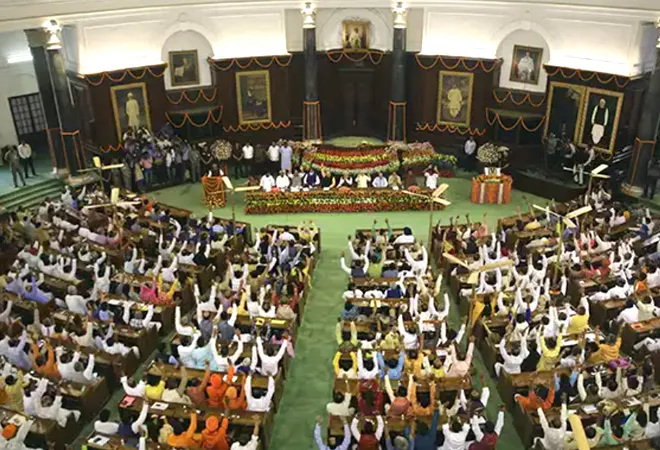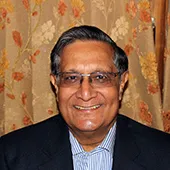 This piece is part of the series, India @75: Assessing Key Institutions of Indian Democracy.
This piece is part of the series, India @75: Assessing Key Institutions of Indian Democracy.
On 15 August 1947 when India became independent, Jawaharlal Nehru became Prime Minister of the country, with Sardar Vallabhbhai Patel as Deputy Prime Minister and 12 other members forming the Cabinet. Thus, as India celebrates the 75
th year of its independence, one can see how far its cabinet system has also matured.
A brief history
As Jawaharlal Nehru formed the interim government at the invitation of Viceroy Lord Wavell in coalition with the All India Muslim League in 1946, he showed a firm commitment to form and run the government by the principles of the cabinet system that evolved with the Westminster model of government. A nine-member interim government of the Congress and other like-minded leaders
functioned between 19 July 1947 and 14 August 1947. Nehru’s commitment to institution-building for independent India was displayed as he
wrote to Viceroy Lord Wavell on 1 September 1946 that “This Government will function as a Cabinet and will be jointly responsible for its decisions.”. Thus, the ball was set rolling even before independence and before the Constituent Assembly had met.
Besides the foundation laid by Nehru during the interim government, the Westminster model of government with the Cabinet as a key institution was preferred also by the Constituent Assembly.
As put forth by Walter Bagehot: ‘The Cabinet, in a word, is a board of control chosen by the legislature, out of persons whom it trusts and knows, to rule the nation.’ Explaining the most crucial trait of the Cabinet, he said, “A Cabinet is a combining committee – a
hyphen which joins, a
buckle which fastens, the legislative part of the State to the executive part of the State. In its origin, it belongs to the one in its functions it belongs to the other.” Thus, the three attributes of the cabinet government are collective responsibility,
primus inter pares prime minister, and political homogeneity. Collective responsibility binds the members of the Cabinet together in agreement not to disagree publicly after a decision has been taken.
Primus inter pares (the first among the equals) prime minister, along with collective responsibility, has evolved gradually over centuries as a united front against the monarch.
Besides the foundation laid by Nehru during the interim government, the Westminster model of government with the Cabinet as a key institution was preferred also by the Constituent Assembly. It was accepted on two grounds: First, as Ambedkar explained in the Constituent Assembly, it ‘is more responsible’ than the American system and, second, Indian leaders had worked with it and had experienced it. Both the Union Constitution Committee and the Provincial Constitution in
their joint session concluded that ‘it would suit the conditions of this country better to adopt the parliamentary system of Constitution, the British type of Constitution with which we are familiar’. The emerging constitutional provisions in Articles 74(1), 75(1) and (3) and 77(3) focused on a
primus inter pares prime minister and collective responsibility of the Council of Ministers (cabinet), while making the cabinet a committee of the Council of Ministers, but more powerful than its creator.
Evolution of the Cabinet System in Post-independent India
After its foundation was laid by Nehru and other prominent leaders of the national movement in 1946, the cabinet system has evolved in India’s own political ecology with 14 prime ministers since 15 August 1947. Nehru’s cabinets—five since 1947—transitioned from being ‘national’ (1947-50) to inclusive and representative (throughout), reflecting different styles of prime ministerial and cabinet functioning; from accommodative (1947-57) to predominant (1957-62) to tenacious manoeuvring by him in his own political frailty (1962-64). His successor, Lal Bahadur Shastri, in his brief 18-month tenure led the Cabinet as a true collegial body, humbly accepting his role as
primus inter pares.
During the entire decade of the 1980s, the government was run as the prime ministerial system and the cabinet system remained in a coma.
Indira Gandhi initially emerged as a strategically acceptable candidate to neutralise a supposedly ‘rigid’ Morarji Desai and was dependent on the organisational bosses in the beginning. However, after the spilt in the party, her cabinet post-1971 mid-term poll victory with a two-thirds majority functioned under the prime ministerial system. She stuck to the same style in her second tenure during 1980-84. Her elder son Rajiv Gandhi succeeded her after her assassination; inheriting the same party structure which he maintained. Obviously, during the entire decade of the 1980s, the government was run as the prime ministerial system and the cabinet system remained in a coma.
The Janata Party that followed was a ‘quick fix’ solution to a missing alternative party. Following rumblings within, Jayaprakash Narain nominated Morarji Desai, who formed his cabinet on 24 March 1977 with a quota for each constituent party. Aware of the ideologically diverse cabinet he headed, Desai
made deliberations of his cabinet participative and consensual. However, with members of the cabinet working at cross purposes, collective responsibility was
always tested Eventually, political rivalries, ideological differences, and power ambitions of several leaders led to the fall of the coalition government.
The functioning of the cabinet system during the coalition era in Indian politics deserves an in-depth analysis. The prevailing political compulsions during the National Front (1989), Chandrashekhar (1990), the United Front (1996 and 1997), the NDA (1998 and 1999) and the UPA (2004 and 2009) compromised the prime ministerial prerogative to form the cabinet, as also the three essential features of the cabinet government. Five of these, the National Front led by V.P. Singh, the Chandra Shekhar government, the two United Front governments and the UPA-I led by Manmohan Singh were dependent on outside support. Though that did not impact the making of their cabinets, functioning and decision-making, particularly on a major dissonant issue, was marred by differences that led to the fall of the government.
A study of the cabinet since its inception shows that the cabinets were carefully crafted by each prime minister to give most of the identities a space in the Cabinet.
Given India’s diverse society, one of the important factors in the forming of the cabinet was a country-wide representation of various social groups and even the regions. A study of the cabinet since its inception shows that the cabinets were carefully crafted by each prime minister to give most of the identities a space in the Cabinet. However, it has not been possible to accommodate all due to its size. Over the years, the size expanded from the initial 22 to 31 (Indira Gandhi 1971), 32 (Rajiv Gandhi 1984) and Manmohan Singh (32, 36), and yet it is not big enough to accommodate all.
Theoretically, being a collegial decision-making body with the prime minister as its
primus inter pares leader, its collegial nature has depended considerably on the political position and personality of the prime minister. Thus, whether it was the second phase of Nehru’s reign, Indira Gandhi since 1971, or Rajiv Gandhi in his entire five-year tenure, or Narendra Modi since 2014, the cabinet has been guided by a powerful prime minister. This has been a universal phenomenon in the Westminster model since the 1960s.
But the prime ministerial power is not the only phenomenon that undermines the institutional dimension of the cabinet system in India. A couple of institutional arrangements during the decade-long tenure of Manmohan Singh–the National Advisory Council (NAC) and Group of Ministers (GoM) and Empowered Group of Ministers (E-GoM)—eclipsed the power of the Cabinet. The NAC was an executive-created committee chaired by Congress President and UPA Chair Sonia Gandhi consisting of civil society leaders, educationists, and other experts, which advised the government on policy matters. However, the advisories signed by Sonia Gandhi were never ignored by prime minister Manmohan Singh. Despite its innovativeness, it did impact the cabinet’s formal power and functioning. The GoMs and E-GoMs were small bodies created with cabinet ministers for special tasks. Their recommendations were normally accepted by the cabinet. The E-GoMs could even issue directives to concerned ministries and departments.
The NAC was an executive-created committee chaired by Congress President and UPA Chair Sonia Gandhi consisting of civil society leaders, educationists, and other experts, which advised the government on policy matters.
While the NAC was dissolved when the UPA was voted out of power in 2014, Prime Minister Narendra Modi scrapped the GoMs and E-GoMs when he assumed power in 2014. However, in December 2020, Modi revived the GoMs and E-GoMs.
Conclusion
Cabinet government in India, thus, presents a fascinating picture of an evolving institution that was nurtured by the first Prime Minister Jawaharlal Nehru since the days of the interim government in September 1946. It was retained after independence and debated intensely by Nehru and Patel during its functioning in the post-partition and independence days. They were also supported by the chairman of the Drafting Committee of the Constitution, Dr B.R. Ambedkar. Thus, this Westminster institutional arrangement that evolved in the United Kingdom (UK) since the 18
th century through its history of an unwritten ever-evolving Constitution was transposed with a rare zeal in post-independent India. It has acquired its own character and style of decision-making given India’s evolving party system and emerging nature of political leadership. It is significant that the debate on the prime ministerial form of government, which started in the UK in the 1960s and evolved over two centuries, began in India in the mid-1950s and intensified since 1970. The era of the coalition government, without much strengthening of the cabinet government, weakened this debate. The Narendra Modi government is decidedly prime ministerial, pushing the cabinet government once again into the shadows.
The views expressed above belong to the author(s). ORF research and analyses now available on Telegram! Click here to access our curated content — blogs, longforms and interviews.



 This piece is part of the series,
This piece is part of the series,  PREV
PREV


